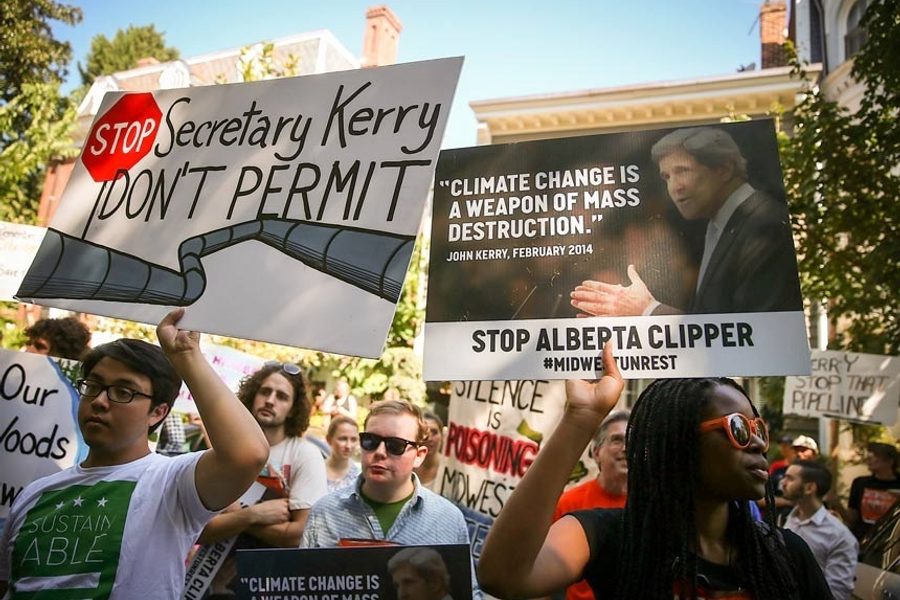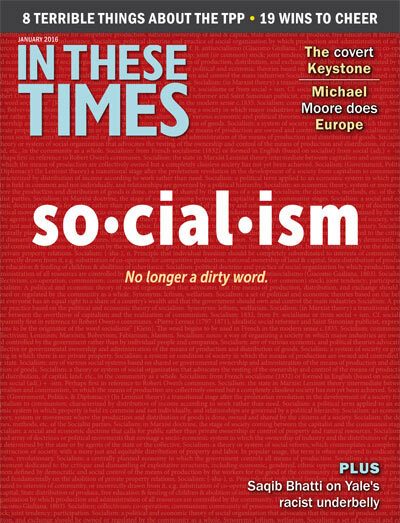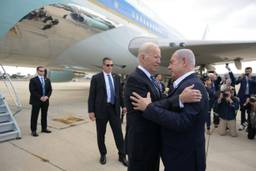The Other Keystone: The Alberta Clipper, the Pipeline No One Is Talking About
The Alberta Clipper pipeline is already transporting huge quantities of oil, but is doing so under the radar.
Branko Marcetic

After years of political jostling, environmental groups celebrated President Obama’s Nov. 6, 2015, rejection of the Keystone XL pipeline. “America is now a global leader when it comes to taking serious action to fight climate change,” he said.
As he spoke, another pipeline known as the Alberta Clipper was already transporting some 800,000 barrels per day (BPD) of tar sands crude — the same type and essentially the same volume of oil as the proposed Keystone — to U.S. refineries.
While Keystone has monopolized public outrage, the State Department has quietly allowed a similar project to move ahead. The Clipper is one link in a broader network of pipelines, operated by Canadian oil giant Enbridge, Inc., that extends from the Alberta tar sands all the way to refineries on the Gulf Coast. Environmental groups warn that this could lead to a dramatic increase in the production of tar-sands oil — one of the dirtiest and most environmentally hazardous types of fuel— with little public scrutiny
Keystone and the Clipper
Keystone and the Alberta Clipper, or Line 67, were both proposed at roughly the same time for the same purpose: transport tar sands oil from the Alberta tar sands to the United States in huge quantities. But while Keystone was condemned to regulatory purgatory and eventually blocked, the Clipper and its associated projects have been allowed to go ahead.
Keystone’s biggest regulatory liability was the fact that it was a single 2,000-mile long stretch of pipeline that would cross a national border and various state boundaries. The fact that it stretched across both Canada and the United States meant both governments would have to agree to the environmentally sensitive project, while its sheer scale meant it was bound to attract unwanted attention and controversy.
Enbridge, meanwhile, appears to have deftly avoided these problems. Rather than one massive pipeline project, Enbridge has instead built or proposed many smaller, seemingly disparate pipeline projects from the Upper Midwest southward.
The Alberta Clipper, or Line 67, is the centerpiece of Enbridge’s crossborder pipeline network. The challenge of exploiting Albertan tar sands oil is that it is not only relatively remote, but land-locked. Upon extraction, it has to be transported to be refined, processed and exported. This was the purpose of the Clipper, which was meant to move the oil from the Alberta tar sands across the U.S.-Canada border to a distribution terminal in Superior, Wisconsin. However, under federal law, any infrastructure project that crosses a U.S. border first requires a federal permit and an accompanying environmental review — the same process that doomed Keystone.
A brief history of the Clipper
Enbridge’s legal maneuvering began from the start. In 2007, the company proposed, and the State Department approved, a permit for the Clipper to operate strictly at 450,000 barrels per day (BPD) — even though Enbridge had built the pipeline with a design capacity of almost double that.
When the State Department carried out an environmental impact statement (EIS) for the project, it only considered the potential impact of the first, smaller capacity — not the pipeline’s full capacity. Several environmental groups challenged the permit in court in 2009 on the basis that the EIS was inadequate. According to those involved, it was known that Enbridge aimed to use the pipeline’s full capacity down the line.
“Enbridge had already made it clear to investors that that was the plan,” says Doug Hayes, staff attorney with the Sierra Club, who was involved in the original lawsuit.
Nonetheless, Enbridge denied they had any current plans to expand, and the judge sided with them and the State Department. The permit for 450,000 BPD was allowed to proceed. By October 2010, Line 67 was operational and was sending this quantity of tar sands oil over the Canadian-U.S. border — around the same time Keystone XL began to capture national attention.
Despite its denials, two years after Line 67 was up and running, in November 2012, Enbridge informed the State Department that it did indeed wish to operate the pipeline at its full design capacity of 800,000 BPD, for which it would need a new permit. This time, however, it would have to go through the process in a post-Keystone America.
In the two years since the Alberta Clipper began transporting oil, Keystone had gone from a little-known project to a full-fledged political controversy. Anti-Keystone protesters had been arrested outside the White House, and celebrities like Mark Ruffalo and Julia Louis-Dreyfus were speaking out against the pipeline.
Sure enough, Enbridge began to feel the pressure. Crowds of protesters turned out for Minnesota’s Public Utilities Commission’s proceeding on the pipeline, and there was massive involvement in the first public comment period held by the State Department in 2013.
On top of this, the permitting process for the Clipper dragged on for more than a year with no progress. Enbridge had already applied for approval from Stephen Harper’s oil-friendly Conservative government to start pushing 800,000 BPD of crude through the 670 miles of Line 67 that lay on Canada’s side of the border. It just needed the State Department’s approval for the project to go ahead.
“Enbridge saw what happened to Keystone XL and some of these other pipelines, and … they decided to avoid this public review process,” says Hayes.
The Clipper “switcheroo”
It was at this point, in 2014, that Enbridge switched tack and utilized what some environmental activists have called an “illegal switcheroo.” Instead of relying on Line 67 to transport 800,000 BPD of crude oil across the U.S.-Canada border, the company would briefly divert the crude to another existing pipeline called Line 3. This segment would then transport the oil across the border before it was ultimately transferred back to Line 67 in Minnesota.
In June 2014, Enbridge’s lawyers outlined the project in a letter to the State Department. They cited the more than year-long “unforeseen Line 67 project permitting delay” as the reason for the project, but also presented Enbridge as a custodian of the public interest. The company had a duty to shippers and refiners, they explained, who would be hit with higher transportation costs if Enbridge didn’t step up its capacity, as well as to ordinary consumers, who might see domestic oil prices spike. Enbridge’s lawyers wrote that the company would proceed with this plan “whether or not a new Presidential Permit is issued.”
This dubious maneuver relied on what critics say was an additional sleight of hand: another new segment of pipeline to carry the crude across the border, packaged as an update to Line 3. In February and March 2014, Enbridge informed the State Department it planned to undertake a “maintenance-driven replacement” of the nearly 50-year old Line 3, which stretched from Edmonton to Superior. But rather than swapping it with an identical but improved replacement, it proposed an entirely new pipeline of a larger diameter that would travel through a different route for 238 miles.
To complete the plan, Enbridge would construct four totally new pipeline interconnections between Line 67 and its new “replacement” Line 3: two at the company’s Gretna, Manitoba station in Canada, and two more in the United States just south of the border.
Because Enbridge already regularly constructed interconnections between adjacent lines “in the event of unforeseen events or contingencies, such as power outages or maintenance,” it argued, it didn’t need a permit for these interconnections.
Ultimately, the State Department acceded to these changes without requiring new permits or environmental reviews. In November 2014, a coalition of tribal and environmental groups filed suit against the department, claiming that it had violated federal preservation and environmental laws and calling for an injunction on the bypass project until it went through the full permitting process.
Emails between Enbridge’s lawyers and the State Department, made public in April 2015 as part of the suit, show staffers apparently working to help Enbridge tiptoe around regulations.
“Enbridge needs to do the horizontal drilling under the 2 rivers in the border segment for Line 3 … two weeks from now,” Ona Hahs, attorney-advisor for the State Department’s Office of the Legal Advisor told State staff in one email. “So we’re running out of time on that one.”
On December 9, the federal judge ruled in favor of Enbridge and the State Department, arguing that the State Department’s decision is not subject to judicial review. For the groups who filed the suit, one option will be to appeal the decision.
As with Keystone, Obama or the State Department could step in and tell Enbridge it needs a permit to keep pumping 800,000 BPD of oil over the border. If left to their own devices, they’re unlikely to do so.
“Through the Keystone campaign, America learned that it could fight pipelines,” says Andy Pearson, Minnesota350’s Midwest tar sands co-ordinator. “The normal has changed. You’re not going to be able to put a pipeline without facing opposition, anywhere in the country.”
In the meantime, Enbridge has already completed construction of the new border segment that connects to the Alberta Clipper, which, since mid-2015, has allowed the company to transport increased volumes of tar-sands crude over the border without further delay.
In an emailed statement, Enbridge spokesperson Lorraine Little told In These Times: “The United States Department of State is well aware of our replacement of Line 3 at the border for maintenance reasons and has advised us that that replacement was consistent with our existing Line 3 permit and requires no further approval and/or environmental review by the Department. … Our operation of Line 67 at the border is likewise fully consistent with the capacity allowed for that line by the existing presidential permit. Further, the Department has acknowledged that is has no regulatory authority beyond the area near the border and our interconnects are located outside that area, thus raising no question as to their legality.”
Enbridge’s end game
Ken Rumelt, staff attorney at Vermont Law School’s Environmental and Natural Resources Law Clinic, says that Enbridge’s endgame has always been clear: Even though projects have been proposed piecemeal, they constitute one large network capable of ramping up transport of Canadian tar sands to the Gulf Coast. More than 50 percent of U.S. refining capacity and most of U.S. heavy crude processing capacity is located on the Gulf.
To that apparent end, Enbridge has a number of other pipeline projects either already in existence or in the works, which form links in this network. The rest of the Line 3 replacement, for one, is due to go online in 2017, at which point it will open up a new corridor for tar sands oil to flow in through the Upper Midwest.
Then there’s Line 61, a huge, 42-inch pipeline built in 2007 that runs from Superior to Flanagan, Ill. Enbridge wanted to triple its currently approved capacity to a massive 1.2 million BPD, which would make it the largest tar sands pipeline in North America. Rather than building anew, Enbridge plans to simply pump more oil through the pipeline, and in September 2015 it was finally able to break ground on the 13th and final additional pumping station. The expansion is expected to go online in summer 2016. Enbridge also has plans to build a “twin” for Line 61 to help carry the flood of extra oil pumped by the Line 3 expansion.
The final links in this tar sands chain have been around for some time. Two pipelines will run nearly 800,000 BPD from Flanagan to Cushing, Okla., where they link up with Enbridge’s 500-mile long Seaway pipeline and its 850,000 BPD capacity “twin.” These pipelines extend all the way to the Gulf Coast.
Two days before Obama’s Keystone rejection, Enbridge announced plans to build import and export facilities at the Gulf of Mexico region. With Congress and President Obama having lifted the United States’ 40-year ban on oil exports in December, Enbridge is now perfectly positioned to export tar sands oil through the Gulf.
“It’s Keystone times two,” says Rumelt.
Enbridge’s incremental approach to pipeline building, critics charge, has helped obscure its endgame of connecting the pipelines into one vast transportation network. By only proposing small local and interstate projects, Enbridge has skirted the much more stringent federal regulation process, while also keeping pipeline fights localized and out of the national press.
This strategy has worked. TransCanada fought and lost a very public, five-year long battle with the federal government over Keystone. When was the last time you heard about Enbridge’s pipelines?
Stonewalling and seizures
To get these projects off the ground, Enbridge has often resorted to underhanded tactics.
“Enbridge has a history of strong arming individual landowners … threatening eminent domain and a slew of other threats and forms of intimidation,” says Elizabeth Ward, the Sierra Club’s conservation programs coordinator.
Eminent domain, the seizure of private property without the owner’s consent for public use, has traditionally been employed by the government for the “public use” of land, such as building highways or schools. In 2004, however, the Supreme Court ruled that private entities could also be granted this power if their plans brought “public benefit” — in other words, if they created jobs or brought other economic gains. While Enbridge prefers to negotiate with landowners over the fair price of their property, if they dispute the price or refuse to sell, the company can use eminent domain to take it — a tactic it has a history of using.
The company has also been accused of stonewalling environmental groups, local tribes and communities, and, in some cases, governmental bodies, keeping projects under a strict veil of secrecy. Several people I spoke with have said the company outright refuses to engage with them about their concerns.
A helping hand from government
The degree to which local and federal governments have been complicit in approving these projects also raises questions.
The State Department was authorizing Enbridge’s ”bypass project” at the same time the Obama administration was making its much celebrated “pivot” toward acting on climate change. In May 2014, two months before the State Department approved the project and one month after it allowed the Line 3 replacement to go ahead, the Washington Post quoted aides and advisers who claimed Obama viewed climate change as “one of the key components of his legacy.” “This is personal for him,” said one.
That same month, the White House put out a report warning of the catastrophe ahead if climate change wasn’t curbed. Later that year, Obama used the occasion of the G20 summit for a dressing down of Australian Prime Minister Tony Abbot over his inaction on climate change. Meanwhile, in February 2014, John Kerry, the head of the same State Department that bent over backwards for Enbridge, declared climate change “the greatest challenge of our generation.”
In fact, Doug Hayes credits the Obama administration with creating the “turning point” for pipeline building.
In the midst of his reelection campaign in 2012, Obama gave a speech in Cushing, Okla., boasting that, under his administration, America had “added enough new oil and gas pipeline to encircle the Earth and then some.” The same day, he issued an executive order cutting the time involved in the federal permitting and review process for infrastructure projects. Since then, says Hayes, federal agencies have regularly segmented oil pipelines when reviewing them and taken the narrowest view of their own jurisdiction, in order to avoid the need for environmental reviews.
Joe Plumer, attorney for Ojibwe of the White Earth Nation in Minnesota, asserts that state agencies haven’t helped either. Rather than regulating Enbridge’s projects, Plumer says, the Minnesota Public Utilities Commission has been rubber stamping them for years.
Opponents say it’s the same across the border in Wisconsin. The Line 61 expansion had faced steep opposition from the residents of Dane County, which had passed a local ordinance requiring Enbridge to purchase extra insurance to cover the county in case of a spill arising from the project. Fortunately for Enbridge, Gov. Scott Walker’s ® government slipped a last minute amendment into the state budget, extending the power of eminent domain to Enbridge and overruling the county’s ordinance.
Anger at this state of affairs is growing. On June 6, 5,000 protesters took part in the Tar Sands Resistance March in St. Paul, partly aimed at the Clipper. Two months later, 100 protesters from a coalition of environmental groups staged a more than four hour-long protest outside John Kerry’s house in Washington, D.C., where 20 protesters were arrested.
More dramatically, on November 2, a broad alliance of protesters staged a sit-in at Enbridge’s office in Duluth, Minn. Two indigenous community leaders attempted to hand Enbridge staff a letter of demands, which included ceasing the Bypass Project. The Enbridge staff physically refused to accept the letter, leading the protesters to slide the letter beneath a locked door. Later that day, Enbridge issued a statement saying it would “continue to engage in conversations with individuals and communities in areas where we have operations or active projects.”
Activists see raising the profile of Enbridge’s projects to a Keystone-like level as essential to stopping it. Mahyar Sorour, an organizer at the Minnesota Public Research Group and one of those involved in the protests, says the key will be to turn the Clipper and its associated projects into large-scale issues with impact beyond the Midwest. She notes that the Clipper crosses twice through the Mississippi river, which nearly 15 million Americans rely on as a source of freshwater.
The trouble with tar sands
Enbridge’s pipelines have a slew of other potential environmentally destructive consequences, chief among them the danger of spilling tar sands oil.
Tar sands crude is a mix of sand, clay, water and bitumen, an extremely heavy type of oil often compared to molasses or peanut butter. Bitumen is so heavy, in fact, it can only flow if heated or mixed with lighter types of oil, which often turn out to be carcinogens. Longstanding health concerns are associated with the stuff. Numerous studies have linked tar sands to cancer, and residents living near one bitumen site in Alberta complained of symptoms such as spasms, headaches, memory loss and pains as a result of heavy oil odors.
The acute density of bitumen makes cleaning it up a Herculean labor. The existing technology for cleaning up oil spills assumes that oil floats in water. But bitumen typically sinks to the bottom of whatever water body it spills in, mixing in with rock and sediment, making it hard to scoop out and necessitating dredging. The result is a costlier and more difficult clean-up operation.
This is all the more alarming when considering where Line 67 alone runs through. The pipeline not only traverses privately owned land, threatening the homes and livelihoods of property owners — it also crosses a number of ecologically significant sites. Aside from the Mississippi River, this includes the Northern Divide, a key juncture from which water flows to the Great Lakes and the Hudson and Mississippi Rivers, and the Chippewa National Forest, location of Minnesota’s five largest lakes, site of eight of its last remaining wetlands and home to the highest breeding population of bald eagles in the lower 48 states.
Indigenous communities are especially impacted. Enbridge’s pipelines go through the Fond du Lac, Red Lake Nation and Leech Lake Indian Reservations, today the home of the Ojibwe people. Pipelines also travel through the region’s wild rice lands, central to both the indigenous communities’ livelihoods and their cultural identities. According to tradition, the Ojibwe originally travelled to and settled in the region because of its wild rice beds, which became a staple of their diet. An oil spill would devastate these wild rice beds, not to mention ravage the land on which the Ojibwe have hunting and fishing rights.
Enbridge’s history is riddled with spills. More than 800 have occurred across the company’s operations between 1999 and 2010. The Clipper itself leaked 125 barrels worth of oil last year at a Canadian pumping station. The transport of tar sands makes spills especially likely.
“Tar sands is like liquid sandpaper,” says Plumer. “It wears the pipe out from the inside.”
To see the potential consequences of a spill, one need only look at what happened in 2010, when a spill on one of Enbridge’s Michigan pipelines poured more than 1 million gallons of tar sands crude into the Kalamazoo River, resulting in the most expensive onshore clean up in U.S. history.
Once in the water, the diluted bitumen separated, with the natural gas liquids that were blended into the mix contaminating the surrounding air and the bitumen sinking to the river bed. A combination of a slow and inadequate response by the EPA and a botched clean-up effort by Enbridge has meant that the river is still contaminated today. Nearby residents were forced to evacuate and many still haven’t returned, while Enbridge, unable to clean the toxic air, resorted to simply buying up some of the abandoned homes.
A new direction on climate change?
The exploitation of tar sands oil has broader implications than these more immediate environmental impacts. In the global effort to halt catastrophic warming of the planet, keeping tar sands in the ground is vital.
Tar sands oil is one of the dirtiest forms of fossil fuels that exists. Because of its complex and energy-intensive extraction and separation processes, producing diluted bitumen ends up burning 8 to 24 percent more carbon than conventional oil. According to the National Resources Defense Council, an average open-pit mine spits out as much greenhouse gas every day as do 1.35 million cars. John Abraham, a professor of thermal sciences at the University of St. Thomas in Minnesota, believes that burning all the Albertan tar sands oil — which comprises an area the size of Florida — would by itself raise the world’s temperature by 0.4 degrees Celsius.
In other words, for the sake of the planet, the Alberta tar sands have to stay in the ground.
“[The oil industry] only has a few limited pipelines that can get this stuff out of Canada and into other markets,” says Lena Moffitt, director of the Sierra Club’s Dirty Fuels campaign. “The Alberta Clipper is one of only two dedicated tar sands pipelines in existence right now.”
If oil prices continue to stay low, this could make exploiting the tar sands simply uneconomical for companies like Enbridge.
“It’s such a high capital investment,” says Doug Hayes. “The break even point is so high that if oil prices are low and there’s not these cheap pipeline transportation options on the market, they are going to curtail production.”
Sure enough, a State Department review found that, since transporting oil by rail is more expensive than via a pipeline, tar sands demand would drop if the price for a barrel of oil fell below $65. The price of oil this year has already fallen to less than $50 a barrel.
President Obama may have put it best, when he rejected Keystone: “Ultimately, if we’re going to prevent large parts of this Earth from becoming not only inhospitable but uninhabitable in our lifetimes, we’re going to have to keep some fossil fuels in the ground rather than burn them,” he said.
Halting the Clipper could be critical to this end. And fortunately, Keystone’s failure has shown that enough pressure can force the government to do the right thing.
A shorter version of this article appears in the January 2016 issue of In These Times.
Branko Marcetic is a staff writer at Jacobin magazine and a 2019-2020 Leonard C. Goodman Institute for Investigative Reporting fellow. He is the author of Yesterday’s Man: The Case Against Joe Biden.









